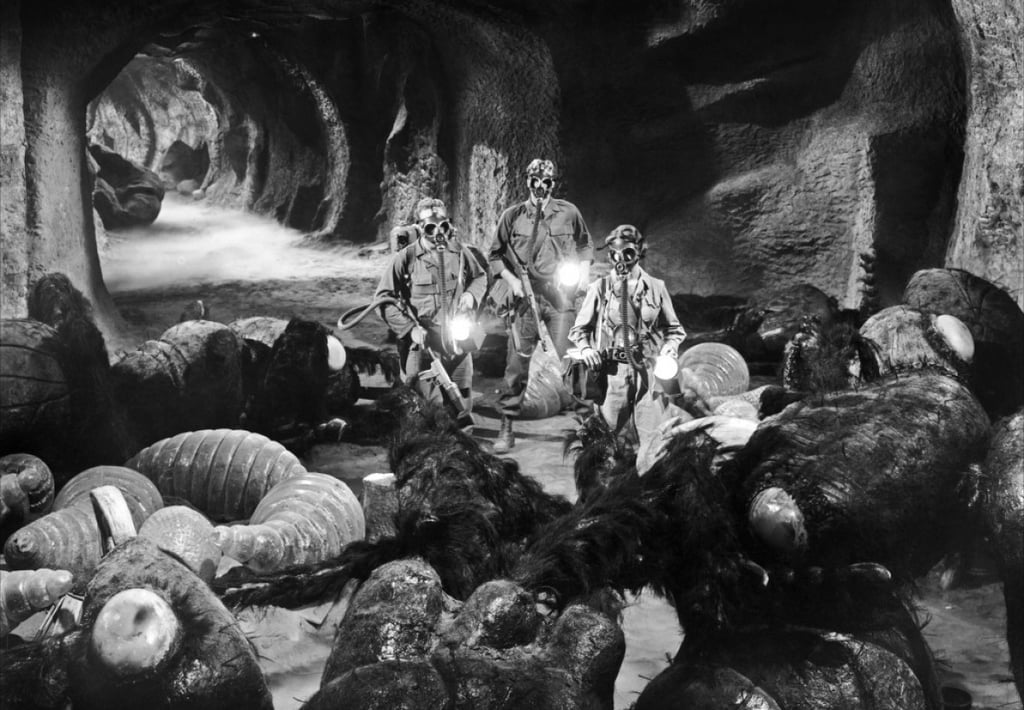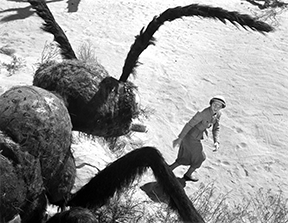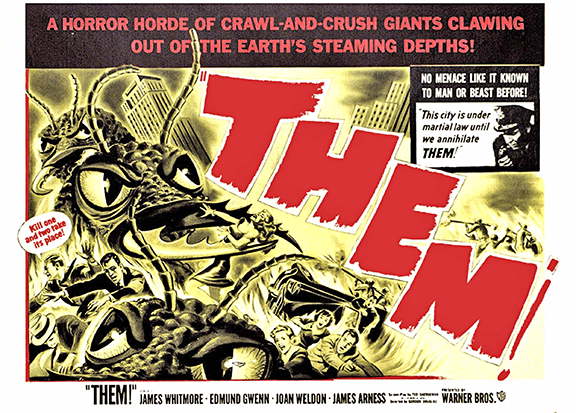Do you love dark cinema like we do?
Them! and The Thing from Another World: Templates for Tomorrow Part Two
In the second and final part, we investigate one of cinema's first giant, mutated insect films and see how it influenced others. THEM! 1 HR 32 MINS Warner Bros.
HORROR/SCIENCE FICTION
written by Gary Svehla
5/5/202510 min read
PART TWO
The Thing from Another World was made in 1951, and Them! three years later, in 1954, this Warner Bros. film initiated and copied various tropes used in giant monster movies. However, this film served as a model for giant monster movies throughout the decade and for science fiction monster movies in general. Remember, it is not necessarily the first film to create a science fiction template. Still, it must be the first to use it effectively in a memorable way, so other filmmakers are encouraged to copy it and make a difference.
Atomic radiation is the be-all and end-all of 1950s monster movies, World War II constantly reminding us of the bombing of Japan, and all the consequences still fresh in the minds of 1950s filmmakers a decade later. Them! is the first of a decade-long sub-genre of giant monster films. And, of course, all these creatures were mutated into their gigantic size by the effects of atomic radiation, which transformed various creatures, even man, into enormous monsters. When Officer Ben Peterson (James Whitmore) and F.B.I. agent Robert Graham (James Arness, in a vastly different role from playing the alien in The Thing) meet the plane carrying two scientists from The Department of Agriculture, Dr. Medford (Edmund Gwenn) and his young daughter Patricia Medford (Joan Weldon), they are prepared to investigate the plaster cast of an unusual footprint. Dr. Medford looks concerned but says he won't reveal what he surmises until he's sure of his theory.
Children in peril is a common theme in many science fiction monster films, with examples including Invaders from Mars, The Monster That Challenged the World, and Aliens. Them! begins with authorities searching for a little girl (Sandy Descher) lost in the desert; aerial shots and standard ones show her dazed expression, wearing her bathrobe and holding her partially broken doll. Two policemen, one of whom is Ben Peterson, approach her, and she remains oblivious to them. Peterson stops her wandering, looking into her open-eyed, blank expression. Tucked into the patrol car, she is nestled in the shoulder of one of the policemen. They investigate a deserted trailer that looks fine from one side, but the side facing away from the road has been smashed and torn apart. The interior is in disarray. The patrolman finds blood, money, and a pistol lying openly on the ground. Under a bed, they find an unusual fragment of shell. Most strangely, they find boxes of sugar open. The policemen radioed for medics and other investigators.
When Dr. Medford questions the now-identified Elinson child, a nurse tells him, “ ... we couldn’t use Carisoprodol to reduce the muscle spasms because she is too young ... she is a perfect case of hysteria conversion.” To bring her out of the trance, Medford fills a glass with formic acid, the same acid that had recently saturated a dead store owner, Johnson, a victim. Smelling the potion, the Elinson girl flicks her eyelids several times, distorting her face as she screams, “Them, them, them!” She continues screaming, “Them!"
Another example of children in peril: In the web of interconnecting sewage drains beneath Los Angeles, the search is on for two missing children, hopefully alive and hiding from the giant ants. The military Jeeps pour together into the opening of the main sewage tunnel and divide to enter smaller tunnels. Less than two miles in, Officer Ben Peterson hears methodical banging at an adjacent tunnel as a despondent mother waits outside, her face filled with supreme dread. Further investigation reveals the two children are alive, but ants surround them in a covey hole. The whirring sound of the ants is overwhelming. Drain 267 is the location of the nest and the new target area. All the Jeeps hurriedly converge there. Peterson enters and immediately uses his flamethrower to torch one of the ants. He then incinerates the second, who holds the children captive. However, unseen by Peterson is a third ant, entering from a side tunnel. The third confronts Peterson as he lifts both boys to the small escape tunnel just in time. The ant’s pinchers grab him and crush him to death, the officer screaming. Graham and his men arrive as even more ants converge. The military uses rifles and automatic weapons to slow the ants’ progression, collapsing the tunnel. Mr. Medford arrives to tell the men to examine the nest to see if more eggs have been hatched; the tunnel continues to collapse in small sections, injuring several troops. The men persevere and find the inner nest populated by two-winged ants and their minions. Medford says no ants have escaped, and the threat will be over once the eggs and ants are destroyed.
Medford wants to be taken to the abandoned trailer after managing to revive the Elinson girl, and arrives during a sand-blowing storm. Peterson shows Medford exactly where the footprint was found. Pat says, “They turned carnivorous,” without telling F.B.I. agent Robert Graham what “they” are. Medford finds another large footprint. “It’s gigantic, measuring over 12 centimeters ... that would make it over 8 feet in length! ... this is monstrous!” Medford and his daughter Pat seem to know what they are dealing with, but nobody else does. And Medford won’t reveal anything until he is sure. But audiences, seeing the posters displayed in the front of the theater, know.
Again, suspense is generated, and otherworldly whirring sounds build up to the revelation of the monster fiend. The giant ants communicate with these sounds, but killer ants of this type haven’t been mentioned yet and are still unknown. So, the ungodly sound that they make is mysterious. Such weird sounds also happen in films such as Beginning of the End, The Crawling Eye, and Man-Made Monster. When the medic arrives to take the Elinson girl to the hospital, the medic (William Schallert) hears the haunting whirring sound, saying, “It’s in the wind; it grows pretty freakish in these parts.”
As the two patrolmen ride to Johnson’s store, they arrive and are greeted by the howling winds, but not the same sound as the whirring sound heard before. As the wind roars, they discover the store in utter disarray, torn apart from the inside out, with a smashed-out outside wall. Officer Peterson finds a rifle with its barrel busted and twisted apart. Johnson is bloodied and dead in the underground shelter, looking like he was carried and dragged there. Officer Peterson leaves the store while the other hears the strange whirring, just like the sound at the scene of the medical ambulance earlier. The lone officer turns out the lights, walks through the store's broken exterior, and then steps further into the fog. Unseen to us, he fires several rounds and screams as the whirring noise changes pitch, overpowering the soundtrack.
In another similar scene, Pat Medford wanders out alone into blowing desert sands, finding another footprint by a sand-covered ridge, hearing the loud whirring sound the dead officer heard before he was killed. The sound continues as Pat and others scan the desert. Pat overlooks the first sighting of a giant ant behind her, slowly approaching the ridge overhead. The ant pursues her as she stumbles across the desert. Graham comes to her rescue, firing his pistol.
Meanwhile, Medford tells Officer Peterson to shoot at the antennae. Peterson runs to his car, returns with an automatic weapon, and destroys the ant. Pat says, “You heard the sound ... communication with others in the colony.”
Finding the giant ant’s newly established nest is the only way to eradicate this terror. Dr. Medford states, “The nest, considering its age, may contain several hundred to several thousand ants.” Pat Medford and Robert Graham fly over an ant hill, and one ant pops out of the nest, carrying skeleton bones deposited in a pile of gathered bones, skulls, and debris.
Medford explains to the commanding general that the ants only leave the nest at night because they hate desert heat. The best chance of destroying the nest is tomorrow’s hottest heat. “We must use heat to keep them inside the nest and cyanide gas to destroy them.” So the military uses bazookas to shoot firebombs at the entrance to the nest, and then they use hand grenades with cyanide gas to destroy them.
Discovering the monster's lair is a classic template for science fiction monster films. Look to Creature from The Black Lagoon, Earth vs. The Giant Spider, The Descent, and It Came from Outer Space. But here, it is essential, as military men wear full-face oxygen masks, looking like insects, as they enter the ant's lair, hoping to find dead ants from the gas already used. Creepy is the quiet mood created as they descend into the lair, using a rope illuminated only by flashlights. Suddenly, ants burst through the rock or earth walls, immediately hit with a barrage of flamethrowers and heat bombs. Remember, this was after the lair was filled with cyanide gas to destroy the nest. “How come the gas didn’t knock them off?” Graham asks. Pat answers, “The chamber looks caved in, probably from the first bombing. Sealed up like that, the gas couldn’t reach them.” Graham announces we are getting out of here. But before they do, they accidentally enter the queen’s chamber and witness her giant eggs lying about. Pat takes pictures and orders the soldiers to burn everything! The Medfords are astounded, finding no larvae and discovering that the ants hatch directly from eggs. Photos shown to Dr. Medford show that two queen ants were hatched, born with wings, and flew away, being carried by air currents. Medford says, “A single queen can lay thousands of eggs ... we only had a close view of the beginning of what will be the end of us!”
Documentary footage is another trope used in this and similar science fiction movies. It legitimizes and explains to the ordinary viewer what is happening. In one scene, the scientists show the documentary footage to the military. Dr. Medford supplies the narration, telling us helpful information, such as, “Ants can carry 20 times their weight, which equals one of you carrying a ton or more.” When the queen mates, the male dies, allowing the queen to be carried by the wind to start new colonies. Dr. Medford summarizes after the film, “Ants are the only creatures on Earth, other than man, that make war. They campaign, they are chronic aggressors, and they make slave laborers of the captives they don’t kill. But even the most minute have an instinct and talent for industry, social organization, and savagery that makes a man look feeble by comparison ... unless the queens are captured and destroyed ... man, as the dominant species of life on Earth, will probably be extinct.”
The autopsy scene returns, allowing the viewer to hear and imagine ghastly things that could not be shown on the movie screen in 1954. When we listen to what has been done to this human body, the tension becomes heightened, and the sense of spoken horror becomes even worse than showing the results. Here, the autopsy of Johnson, the store owner, is revealed by the county medical examiner, who says he could have died in one of five ways: “His neck and back were broken, his chest was crushed, his skull was fractured, and here’s one for Sherlock Holmes, there was enough formic acid in him to kill 20 men.”
Most science fiction horror films feature sequences of a panicking crowd. They are a common trope; such sequences are essential to the movie's success. How many times have we seen the panicking crowd run uncontrollably from the deadly threat, the monster approaching, destroying buildings, and innocent people dying in the rubble and debris? To understand what I mean, imagine movies such as 20 Million Miles to Earth, The Giant Behemoth, War of the Worlds, and Gorgo. These types of films depict humanity on the run, panicking in the face of unknown threats, losing control, and frantically searching for survival. The massive crowd panic scene is iconic, but such movies often have one or two people panicking because of budgetary constraints or the script, usually resulting in an even more effective chaos effect. Think of Miles Bennett in Invasion of the Body Snatchers to observe the effectiveness of one or two characters ’ panic.
Here, in Them!, we have the military frantically trying to quell the worldwide panic that would be caused by giant ants running amok. Such damaging news must be suppressed at any cost. One such example is expressed by soon-to-be Disney super-star, Fess Parker (he of the coon skin cap playing Davey Crocket), here playing good-ole-boy Alan Crotty, a man who crashed his private plane after seeing giant ants roaming the desert, which he calls UFOs, and which landed him in a psychiatric hospital. “You ain’t kidding me, not you or nobody, this ain’t no hospital. It’s a loony bin, a nut house! You think I’m crazy, and I don’t care what you think; I’m not crazy!!! I saw those things with my own two eyes. You think somebody can make up a story like that?” Promising that the assembled people will not laugh at him, Crotty tells his fantastic tale of seeing flying saucers and giant ants. After he finishes his truthful story, he asks Graham to put in a good word with his doctor to get him out of this hospital. But Graham tells the doctor that Crotty must be isolated and receive no visitors because of national security.
In a brief sequence approximating the panicking crowd scene, we are taken aboard the sailing vessel “The Viking." Here, we find sailors scrambling in panic as one lone giant ant attacks. One crewman escapes to a side room, where he attempts to send a wire for help. But the ant crashes through the glass wall and kills him. Later, it was reported that there were no survivors.
Lastly, the final template is the bevy of apocalyptic speeches, either quoting from the Bible or other great minds, predicting the potential end of humanity. Science fiction monster films have a solemn tone in their tales of gloom and doom. There is always an out for humankind if we only learn from our mistakes, face the challenges of a new era, strive to be better, braver, and more intelligent, and tackle problems head-on. The science fiction monster film often warns of good things to come if we can overcome our current threat. We have already revealed one of Dr. Medford’s insightful speeches earlier. But to illustrate two others, we are being told that as multiple flamethrowers are consuming the ants, “When man entered the atomic age, he opened a door to a new world. What we eventually find in that new world nobody can predict.” And in a more religious reference, Medford says, “We may be witnesses of a biblical prophecy come true ... And the beast shall reign over the Earth.”
The best science fiction monster films always feature screenplay hooks or plot devices that beg to be copied in future movies of this kind, and the most inventive ones often find themselves repeated and imitated. In this way, the monster genre progresses, improves, and grows. Templates become the genre's building blocks, helping one or two good movies produce many inventive monster movies. And the genre becomes stronger because of it!


THE MILITARY INVADES A NEST AFTER FLOODING IT WITH CYANIDE GAS, KILLING MOST OF THE ANTS.


IN THE DESERT, PAT MEDFORD IS PURSUED BY A GIANT ANT.


Get in touch
garysvehla509@gmail.com


